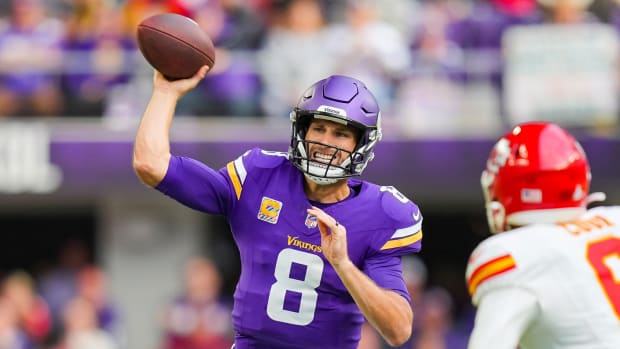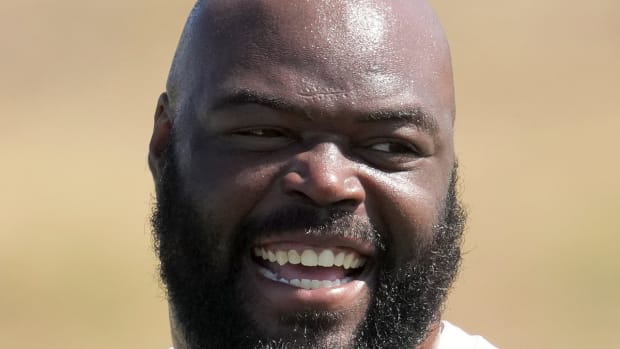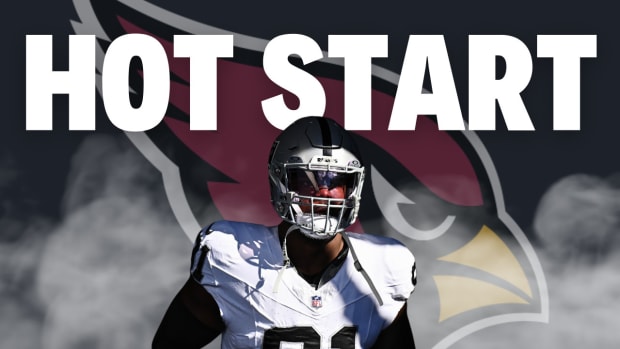Projecting the NFL Draft: NFC East
Projecting the NFL Draft: Problems and solutions for teams in the NFC East
Cowboys’ Problems
By Andy Benoit
The No. 27 overall pick will likely be dedicated to defense. Greg Hardy’s arrival took care of their most pressing need: edge rusher. He’s one of the five best all-around 4-3 pass rushers in football. But Hardy’s untrustworthiness tempers any ideas about him being a long-term solution. Plus, you can never have too many pass rushers, especially in a vanilla 4-3 defense like Rod Marinelli’s.
Another area of need: outside linebacker. Anthony Hitchens runs well, but the even more athletic Bruce Carter left in free agency (Tampa Bay). Lastly, given the tepid opinions about Brandon Carr, plus Morris Claiborne’s inconsistency and injury woes, don’t be surprised if Jerry Jones (or is it Stephen Jones?) jumps at a corner early in the draft if the right one falls to them.
Perhaps one reason the Cowboys allowed DeMarco Murray to walk is because this year’s draft offers an exceptionally deep class of running backs. As Dallas boasts arguably the NFL’s most formidable offensive line of the last 10 years, it’s foreseeable that a rotation of Darren McFadden, Joseph Randle and a second-or third-round rookie could give the Cowboys a top-five ground game.
Another possibility in the early or middle rounds might be a developmental quarterback. Tony Romo has had back injuries and will turn 35 in April. Some of his physical tools, including arm strength, are showing early signs of decline. Not insignificantly, this is starting to impact Dallas’s offensive approach.
More NFL Draft Projections:AFC East ... AFC North ... AFC South ... AFC West
Cowboys’ Solutions
By Andy Staples
The Draftu2019s Top Corners
The draft's top cover men are the soft-spoken Trae Waynes and the brash Marcus Peters. How much does personality play into a corner's draft stock? FULL STORY
It seems unlikely any cornerback worth a first-round pick will fall to No. 27. So let’s get them a multifaceted defensive end who will thrive in a 4-3. That man is Mississippi State’s Preston Smith, whose speed (4.57-second 40) and long arms (34 inches) make him a formidable rusher, and whose superior leverage also allows him to set the edge and stuff the run. Smith was the steadiest of the elite defensive linemen in the SEC last season. He isn’t superhuman, but he also doesn’t disappear for long stretches, either.
Dallas should have plenty of options in the second or third round to beef up the running back corps. Miami’s Duke Johnson, a smooth runner who finds creases where they don’t appear to exist, should be around in the second. So should Indiana’s Tevin Coleman. A foot injury has kept Coleman from doing too much during the pre-draft process, but the fact that he averaged 7.5 yards a carry on a bad team against good competition suggests he might be undervalued at the moment.
Since the Cowboys are one of the teams that can afford to develop a young quarterback, they might consider Baylor’s Bryce Petty in the third round. Petty is coming from an extremely unusual college offense and will need time to learn an NFL scheme, but he is a smart player with a live arm. If he pans out, Cowboys brass would look like geniuses. If not, they burned a third-round pick. It’s an acceptable risk. Later, the Cowboys can find some help at outside linebacker. Early in the draft, a bunch of guys who played defensive end in college but are too light to play it in the NFL will get selected. In the middle and late rounds, guys who have actually played linebacker will be available. So the Cowboys could get some value by taking Oklahoma’s Geneo Grissom or Jordan Hicks from Texas.
Giants’ Problems
By Andy Benoit
Defensive tackle Johnathan Hankins, a second-round selection in 2013, played extremely well in the first half of last season and is one good year away from becoming a cornerstone up front. But he needs a running mate. Maybe 2014 third-rounder Jay Bromley is that guy. And there’s veteran defensive end Cullen Jenkins, an excellent technician inside, where he often aligns in nickel. But instead of leaning on part-time D-tackles or young guys with question marks, GM Jerry Reese, who comes from the George Young/Ernie Accorsi School of Defensive Linemen Galore, could spend a first- or second-round pick here, with the idea of not worrying about starters at the position for the next five years.
It’s almost a sure thing that Reese will invest a pick or two at safety. The only two on the rosters are Nat Berhe and Cooper Taylor, both recent fifth-round picks who haven’t played much even in a Giants secondary that’s been rocked by injuries.
Offensively, the right side of the offensive line must improve. Having Geoff Schwartz back healthy could help. Justin Pugh, on the other hand, is clearly not panning out at right tackle. He lacks the lower body strength to anchor. The smart move would be to play Pugh at guard and draft a new tackle.
More NFL Draft Projections:AFC East ... AFC North ... AFC South ... AFC West
Giants’ Solutions
By Andy Staples
If Jerry Reese wants each of his linebackers to treat him to a steak dinner, he’ll draft Washington tackle Danny Shelton at No. 9. Shelton is 6-2 and 339 pounds, and he will keep those linebackers clean by occupying blockers. Pair Shelton and Johnathan Hankins, and the middle of the line of scrimmage is closed. If Shelton is gone, Malcom Brown of Texas could be an excellent addition.
The Legend of Brandon Scherff
He was once just a typical rebound-grabbing, tape-measure home-run-mashing, serve-and-volleying, trombone-playing 270-pound high school QB. Then Scherff kept growing until he was the NFL draft's best—and nastiest—o-line prospect. FULL STORY
In the second round, the Giants could address their safety deficiency by taking Cody Prewitt from Ole Miss. Prewitt played centerfield in an excellent Rebels secondary. At 6-2 and 208 pounds, he looks like a box safety but can be a lot more than that. Much later in the draft, New York could further beef up that group by grabbing either Oregon’s Erick Dargan or UCLA’s Anthony Jefferson. No fifth- or sixth-round pick is a sure thing, but dependable players who faced quality competition in good conferences seem to have the best chance of panning out.
At offensive tackle, the Giants may have a chance to roll the dice in the third round on Texas A&M’s Cedric Ogbuehi. He probably would have been a first-rounder had he left College Station after the 2013 season, but he chose to return for his senior season and was already sliding down draft boards before he tore his ACL in the Aggies’ bowl game against West Virginia. Now there is no telling where Ogbuehi will go in the draft or what he’ll be able to give a team. But here’s the silver lining: If Ogbuehi can recover—the team that selects him will have to accept the possibility that his rookie year is dedicated to rehab—then he might return to that first-round form he showed in 2013. If he does, he’s a long-term solution at a tackle spot for some lucky team. If the Giants would rather find a plug-and-play tackle in the middle rounds, they’re probably better off going for Daryl Williams of Oklahoma or Rob Havenstein of Wisconsin.
The MMQB Podcast: Andy Benoit with Robert Klemko and Greg Cosell
[soundcloud url="https://api.soundcloud.com/tracks/197451685" params="color=ff5500&auto_play=false&hide_related=false&show_comments=true&show_user=true&show_reposts=false" width="100%" height="166" iframe="true" /]
Eagles’ Problems
By Andy Benoit
Chip Kelly reconfigured his entire backfield this offseason but did not find a replacement for receiver Jeremy Maclin. Wideout figures to be a prime need for the Eagles. It may not be the primary need, however. Maclin was coming off the most prolific season of his career. And so was DeSean Jackson last year, when Kelly released him. Kelly might not believe his system can prosper with just any old receiver, but he seems to believe it can prosper without a feared one. Don’t be surprised if he waits until the middle rounds to address this position.
And don’t be surprised if Kelly still goes after a quarterback. Without mobility under center, Kelly can’t use the entirety of his rushing scheme. As a passer, Sam Bradford has a quicker release than Nick Foles, making him a better fit for Kelly’s aerial designs. But Bradford does nothing for the ground game. If Kelly truly believed Bradford was his long-term answer, he’d sign him to a long-term deal now, while his market value is low. With his contract expiring after this season, Bradford is on a one-year trial. It’s not hard to envision Kelly abandoning that trial on draft night if he sees the right opportunity to move up for Marcus Mariota.
If Kelly addresses the defense early in the draft, it will be in the secondary. Free-agent pickup Byron Maxwell is a good fit for a Cover-3 man-zone hybrid scheme, which D coordinator Bill Davis now figures to use more. But fellow ex-Seahawk Walter Thurmond, also signed in free agency, is strictly a slot guy, leaving open the cornerback spot opposite Maxwell.
More NFL Draft Projections:AFC East ... AFC North ... AFC South ... AFC West
Eagles’ Solutions
By Andy Staples
If the Eagles seek a cornerback with No. 20, Michigan State’s Trae Waynes likely will be gone. But Washington’s Marcus Peters could still be on the board. As The MMQB’s Robert Klemko wrote, Peters might be the most well-rounded corner in the draft. This presents a quandary for Chip Kelly.
Joe Banner on Chip Kelly
Former Eagles president Joe Banner assesses the flurry of roster-overhauling moves made by Philadelphia coach Chip Kelly, including the importance of Kelly's sports science work. FULL STORY
When he got things rolling at Oregon, one of his main edicts in recruiting was to avoid players who produced drama—even if they were better than another recruit at the same position. In Eugene, Kelly believed a harmonious locker room made the team better. Peters got thrown off the team at Washington mid-season, and it wasn’t because of an arrest. He created drama that Huskies coach Chris Petersen couldn’t handle any longer. Peters has since smoothed things over with Petersen, but expect Kelly to do serious homework before he considers drafting Peters. And if Kelly decides Peters is too risky for his tastes, he might go for Wake Forest’s Kevin Johnson, an excellent player who was stuck on a bad team in college.
In the second round, the Eagles might be able to pick up UCLA quarterback Brett Hundley. He played in a quick-trigger offense under Noel Mazzone, with similar timing and pacing to Kelly’s offense in Philadelphia. Hundley is also sneaky fast, but would much rather stay in the pocket than run.
At receiver, the Eagles should have some attractive options in the middle and later rounds. Kansas State’s Tyler Lockett could be available in the third round and will make some NFL team very happy as a slot receiver. Georgia’s Chris Conley is another intriguing option. Conley’s combine numbers (4.35 40, 18 bench reps at 225, 45-inch vertical jump, 139-inch broad jump) were eye-popping, but his receiving numbers in college were not (36 catches for 657 yards last season). But there may have been good reasons for Conley’s lack of production. I explained those a few weeks ago in this column on players who might be better in the NFL than they were in college.
Washington’s Problems
By Andy Benoit
What Washington really needs is a new quarterback. Jay Gruden knows it, but Daniel Snyder does not. Hopefully it will be new GM Scot McCloughan’s decision, but it’s hard to see him taking this drastic measure in Year One on the job—especially given the paucity of quality QBs in this draft. But he might tab a backup, as Kirk Cousin’s contract expires after this season.
The rest of the offense is brimming with talent, so McCloughan can focus on the defense. He already addressed the front line in free agency, signing Stephen Paea for four years, $15 million guaranteed and Terrance Knighton for one year at the astounding bargain of $4 million. Ricky Jean-Francois was also brought into the fold, giving Washington early-down depth.
It will be interesting to see if new defensive coordinator Joe Barry runs a 4-3, as he was associated with in Tampa Bay and Detroit, or if he features a 3-4, which he operated under the past four years as San Diego’s linebackers coach. Either way, Barry needs an edge rusher to replace Brian Orakpo. If Washington feels that last year’s second-rounder Trent Murphy is that guy (he has shown flashes), then this can be addressed in the middle rounds. If that’s the case, expect someone for the back seven to be tabbed in the first round. At ’backer, Keenan Robinson proved that he can play all three downs, but another outside starter is needed. At defensive back, Phillip Thomas has been mistake-prone at safety (perhaps due to inexperience). And cornerback is a perpetual area of need for this club, and that remains true even with Bashaud Breeland’s drastic improvements as a fourth-round rookie last year and the offseason addition of overpaid ex-Niner Chris Culliver.
THE MMQB PODCAST: Andy Benoit and Greg Cosell on the 2015 wideouts, and more
More NFL Draft Projections:AFC East ... AFC North ... AFC South ... AFC West
Washington’s Solutions
By Andy Staples
This was a good year to lose Brian Orakpo, because a quality pass rusher should be available at No. 5. The Buccaneers are taking a quarterback. Let’s assume the Titans take Leonard Williams at No. 2 and that the Raiders take a receiver at No. 4 (because they’re the Raiders). Depending on what the Jaguars do at No. 3, that means Florida’s Dante Fowler Jr., Clemson’s Vic Beasley or Nebraska’s Randy Gregory will be available when Washington selects. Fowler might be the most ready to plug and play; he moved around a lot at Florida. But he’s also the most likely to be off the board. Beasley, who came to the combine at 6-3 and 246 pounds but played at 235 for the Tigers, probably could play in a 4-3 or 3-4. Ditto for Gregory, who is leaner at 6-5 and 235. All are excellent attacking the quarterback, so it likely will come down to which player fits best in Washington’s scheme.
In the second round, the brass can get Barry a versatile linebacker by taking Mississippi State’s Benardrick McKinney. At 246 pounds, McKinney is plenty big to handle the pounding in the middle, but the former high school quarterback moves well enough to play on the outside as well. On the draft’s third day, Washington could add more depth at linebacker by grabbing a volume tackler like Kansas’ Ben Heeney or Baylor’s Bryce Hager.
Washington might find their quarterback of the future in Colorado State’s Garrett Grayson early in the third round. Grayson played in a multifaceted offense under Jim McElwain that should allow him to transition more easily to the pro game than many of his classmates. It’s nearly impossible to predict how most quarterbacks will adjust to the NFL, but Grayson has the basic tools he needs to thrive.
Follow The MMQB on Facebook, Twitter and Instagram.
[widget widget_name="SI Newsletter Widget”]


















































